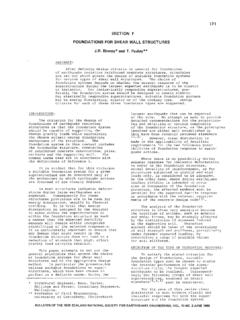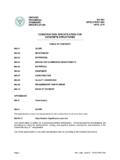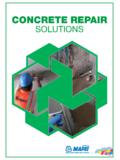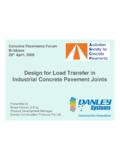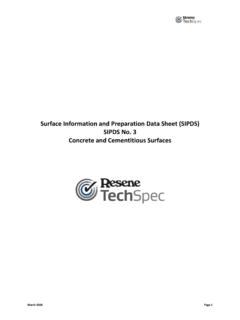Transcription of ANCHORAGE OF TRANSVERSE REINFORCEMENT IN …
1 165 ANCHORAGE OF TRANSVERSE REINFORCEMENT IN rectangular reinforced concrete COLUMNS IN SEISMIC DESIGN H. Tanaka1, R. Park2, B. McNamee3 SYNOPSIS Four reinforced concrete columns with 400 mm ( in) square cross sections were tested under axial compressive load and cyclic flexure to simulate severe seismic loading. The longitudinal REINFORCEMENT consisted of eight bars. The TRANSVERSE REINFORCEMENT consisted of square perimeter hoops surrounding all longitudinal bars and cross ties between the intermediate longitudinal bars. The major variable of the study was the type of ANCHORAGE used for the hoops and cross ties. The ANCHORAGE details involved arrangements of perimeter hoops with 135 end hooks, cross ties with 90 and/or 180 end hooks, and cross ties and perimeter hooks with tension splices.
2 Conclusions were reached with regard to the effectiveness of the tested ANCHORAGE details in columns designed for earthquake resistance. KEYWORDS Columns, cross-ties, detailing, ductility, earthquake resistance, rectangular hoops, reinforced concrete , REINFORCEMENT ANCHORAGE , tension splices, TRANSVERSE REINFORCEMENT . LIST OF SYMBOLS steel stress ch "sh f 1 c area of reinforcing bar area of concrete core measured to outside of peripheral hoop area of concrete core measured to outside of peripheral hoop gross area of column section total effective area of hoop bars and cross ties in direction under consideration per hoop set = area of shear REINFORCEMENT per hoop set = web width = neutral axis depth, or smaller of the distance measured from the concrete side face to the centre of bar or one-half of clear spacing of spliced bars plus a half bar diameter.
3 But not larger than 3d^ = distance from extreme compression fibre to centroid of the tension REINFORCEMENT = bar diameter = concrete compressive stress = concrete compressive cylinder strength Associate Professor, Akashi Technological College, Japan. Professor of Civil Engineering, University of Canterbury, New Zealand. Professor of Civil Engineering, Drexel University, h" h c H H u K I M. AC I ^SlKP yield strength of TRANSVERSE REINFORCEMENT distance from centre of central stub to horizontal load pins at ends of column units width of concrete core measured to outside of peripheral hoop width of concrete core measured to centres of peripheral hoop horizontal force theoretical ultimate horizontal load given by Eq. 16 distance from section of maximum moment to section of zero moment development length equivalent plastic hinge length measured moment in column at face of central stub maximum measured moment in column at face of central stub theoretical flexural strength calculated using ACI concrete compressive stress block theoretical flexural strength calculated using the modified Kent and Park concrete compressive stress distribution = axial compressive load on column = centre to centre spacing of hoop sets = centre to centre spacing of hoop sets given by Eq.
4 Given by Eq. 10 9 BULLETIN OF THE NEW ZEALAND NATIONAL SOCIETY FOR EARTHQUAKE ENGINEERING, Vol 18, No 2, JUNE 1985 166 Vc = given by Eq. 12 V = factored (ultimate) shear force u Zm = given by Eq. 17 cc = compressive cylinder strain ecc = comPressive cylinder strain at extreme fibre of core concrete e = steel strain s A = horizontal displacement = given in Fig. 17 AFC = given in Fig. 17 A = horizontal displacement at first y yield ^ _ curvature = rotation per unit length or strength reduction factor d> = curvature at first yield p = ratio of volume of TRANSVERSE REINFORCEMENT to volume of concrete core p = A /b d w s w 0 = rotation of central stub due to unsymmetrical plastic hinging y = nominal displacement ductility N factor = A/AY yR = real displacement ductility factor = or A, /A.
5 T y by 1 . INTRODUCTION Considerable efforts have been made in recent years to develop improved seismic design provisions for reinforced concrete columns in bridge substructures and building frames. The need for effective design provisions has been emphasised by damage caused to bridges and buildings during severe earthquakes. For example, the San Fernando earthquake in Southern California in February 1971 caused extensive damage to a number of recently constructed reinforced concrete columns in bridges and buildings, mainly because of inadequate detailing of those structural members for ductility (see Fig. 1). The most important design consideration for ductility in the potential plastic hinge region of reinforced concrete columns is the provision of sufficient TRANSVERSE REINFORCEMENT in the form of rectangular arrangements of hoops, with or without cross ties, or circular spirals or circular hoops, in order to confine the compressed concrete , to prevent buckling of the longitudinal bars, and to prevent shear failure.
6 ANCHORAGE failure of the TRANSVERSE REINFORCEMENT must be prevented if that REINFORCEMENT is to function effectively. Seismic design codes normally specify design provisions for the quantity, spacing and ANCHORAGE of TRANSVERSE REINFORCEMENT in the potential plastic hinge region of columns. The New Zealand concrete design code [1] specifies that hoops and cross tie REINFORCEMENT in reinforced concrete columns shall be anchored either by end hooks formed by a 135 turn around a longitudinal bar plus an extension of at least eight hoop or cross tie bar diameters at the free end of the bar into the core concrete , or by welding the bar ends. These ANCHORAGE details can result in a complicated REINFORCEMENT fixing job, especially on site. This is because the hoops and cross ties need first to be placed over the ends of longitudinal bars and then shifted along the longitudinal bars to their correct position in the reinforcing cage.
7 That is, the hoops and cross ties cannot be inserted directly through the side of the cage into their correct position. In order to ease the difficulty of placing TRANSVERSE REINFORCEMENT several alternative details for cross ties which simplify the fabrication of reinforcing cages have been used in the United States and other countries. One alternative detail involves the use of cross ties with 90 and 135 end hooks alternating along the member. Such cross ties can be inserted directly into the position from each side of the cage (see Fig. 2b) after the hoops are in place. Another alternative detail involves the use of 'J1 bars which have a 135 end hook and are inserted from each side of the cage and lapped in the core concrete (see Fig.)
8 2c). Such 'J' bars can be used if the column size permits development of the tension splice. A further alternative detail is to use 'U' bars which are inserted from each side of the cage and lapped in the core concrete (see Fig. 2d). This 'U1 bar detail is not recommended for TRANSVERSE bars passing around the longitudinal bars in the corners of columns since the tension splice will not be effective in the cover concrete if the cover concrete spalls at large column deformations during severe seismic loading. It should be emphasised that there is no great difficulty in fabricating standard reinforcing cages incorporating TRANSVERSE REINFORCEMENT with 135 end hooks and no tension splices (see Fig. 2a), providing the fabrication is off site. In factory conditions cranes are readily available and reinforcing cages can be fabricated in the most convenient positions.
9 However, the fabrication of cages on site in formwork using TRANSVERSE REINFORCEMENT with 135 end hooks and no splices can cause difficulty. The alternative TRANSVERSE REINFORCEMENT details shown in Fig. 2b, c and d may be effective enough to be used in a number of cases, for example where columns need only to be detailed for limited ductility. This paper describes test results obtained from four reinforced concrete columns which contained the various arrangements of TRANSVERSE REINFORCEMENT shown in Fig. 2. The columns were loaded under axial compressive load and cyclic flexure in the inelastic range to simulate severe seismic loading. The performance of the columns at various levels of displacement ductility factor was compared. 167 Fig. 1 Damage Caused to Some reinforced concrete Columns in Bridge and Building Structures During the 19 71 San Fernando Earthquake.
10 ^ (a) Standard Hoop and Cross Tie with 135 End Hook "7 (b) Alternating 90 and 135 End Hooks (c) Overlapping "J" Bars with Tension Splices id) Overlapping "U " Bars with Tension Splices Minimum Values y 0 NZS 3101(1) 8dD 135 ACI 318 (2) 10db 135 6db 90% SEAOC (3) 10dD 135 CEB-FP(4) 10dD 135 AIJ (5) 6dD 135 Where alternated with 135 end hooks Fig. 2 Standard and Alternative Details Fig. 3 ANCHORAGE of TRANSVERSE REINFORCEMENT for Anchoring TRANSVERSE Around a Longitudinal Bar According REINFORCEMENT for reinforced to Some Codes.
